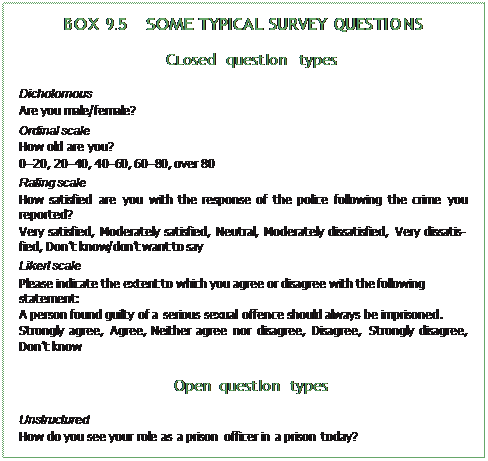 |
Generating survey data on sensitive topics and with vulnerable groups
|
|
|
|
GENERATING SURVEY DATA ON SENSITIVE TOPICS AND WITH VULNERABLE GROUPS
In this second part of the chapter, we consider how to use surveys and questionnaires to produce ethically sound data on sensitive topics and with hard-to-reach groups. Here, we outline key points for consideration before undertaking sensitive survey
research and show how these work in action by providing two examples of surveys that we have worked on. One of our examples, ‘The Children and Young People’s Safety Survey’ (Gallagher et al., 1998), involves a vulnerable population and a sensi- tive topic, and the other, Public attitudes to sex offenders (Brown et al., 2007), concerns a particularly emotive and sensitive topic. The design and implementation of the survey methods affect the quality, validity and reliability of the data. When the topic or the population to be researched are defined as sensitive, a further level of complexity is added as sensitivity affects almost every stage of the research process (Lee, 1993; Lee and Renzetti, 1990) and should be considered in the conceptualiza- tion, piloting, implementation and dissemination processes.
To provide a valid method of gathering attitudes and experiences, surveys should be constructed to be ethically sound, discreet and anonymous.
 |
IDENTIFYING AND DESIGNING SUITABLE RESEARCH QUESTIONS
Surveys are frequently associated with studies of prevalence and incidence, and research on sensitive topics is often concerned with estimating the extent of phenom- ena that are hidden. Uncovering the extent or frequency of a particular type of deviant behaviour, the size of a hidden deviant population, or the extent of experiences of victimization can all be researched appropriately using the survey method – see, for example, Gfroerer and Kennet’s (2014) survey on the nature and extent of substance use, from which they conclude that a tailored approach to survey design, that con- siders the advantages and disadvantages of varied design options, can produce the
most efficient surveys. Furthermore, survey methods can be used to research atti- tudes and opinions – see, for example, De Cao and Lutz’s (2014) survey measuring attitudes towards female genital mutilation in which a ‘list experiment’ asks respondents to express levels of agreement with a range of statements comprising a mix of sensitive and non-sensitive items. De Cao and Lutz found that respondents were more likely to share their real attitudes concerning the sensitive issue of FGM using a simple list technique. Finally, the survey has been shown to be a useful tool in exploring perceptions and definitions around sensitive topics: in our own research, in surveying public attitudes towards sex offenders (Brown et al., 2007), vignettes were used to ask sensitive attitudinal questions in an indirect way (see Survey Example 2, later in this chapter). Box 9. 5 gives examples of different types of questions used in survey research that can help explore attitudes, definitions, values and perceptions.
|
|
|
 |

Designing a survey so that it is accessible to the respondent group seems obvious but can be surprisingly difficult. For example, for each question the researcher needs to think: how are respondents going to understand and answer this question? Have I used appropriate terminology and language? The researcher needs to put them- selves in the respondents’ shoes and stay there throughout the design and piloting phases. This ensures that the presentation and phrasing of questions are appropriate, engaging, interesting and as unthreatening as possible. The role of the survey researcher is to minimize the feeling of threat so as to gain detailed, accurate and reliable data in an ethical manner. There are a number of threat-reducing techniques that can be used, such as leading gently up to sensitive questions and using computers for self-completion questions. But by far the most significant factor in de-sensitizing a topic is the choice of suitable questions. Here, we provide an overview of the dif- ferent types of questions developed and discuss the potential advantages and pitfalls of question design.
|
|
|


